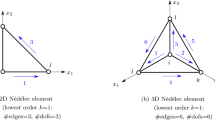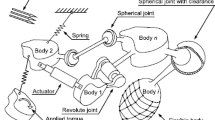Abstract
The solution of the constrained multibody system equations of motion using the generalized coordinate partitioning method requires the identification of the dependent and independent coordinates. Using this approach, only the independent accelerations are integrated forward in time in order to determine the independent coordinates and velocities. Dependent coordinates are determined by solving the nonlinear constraint equations at the position level. If the constraint equations are highly nonlinear, numerical difficulties can be encountered or more Newton–Raphson iterations may be required in order to achieve convergence for the dependent variables. In this paper, a velocity transformation method is proposed for railroad vehicle systems in order to deal with the nonlinearity of the constraint equations when the vehicles negotiate curved tracks. In this formulation, two different sets of coordinates are simultaneously used. The first set is the absolute Cartesian coordinates which are widely used in general multibody system computer formulations. These coordinates lead to a simple form of the equations of motion which has a sparse matrix structure. The second set is the trajectory coordinates which are widely used in specialized railroad vehicle system formulations. The trajectory coordinates can be used to obtain simple formulations of the specified motion trajectory constraint equations in the case of railroad vehicle systems. While the equations of motion are formulated in terms of the absolute Cartesian coordinates, the trajectory accelerations are the ones which are integrated forward in time. The problems associated with the higher degree of differentiability required when the trajectory coordinates are used are discussed. Numerical examples are presented in order to examine the performance of the hybrid coordinate formulation proposed in this paper in the analysis of multibody railroad vehicle systems.
Similar content being viewed by others
References
Barbosa, R.: A 3D contact force safety criterion for flange climb derailment of a railway wheel. Veh. Syst. Dyn. 42(5), 289–300 (2004)
Berzeri, M., Sany, J.R., Shabana, A.A.: Curved track modeling using the absolute nodal coordinate formulation. Technical Report # MBS00-4-UIC. Department of Mechanical Engineering, University of Illinois at Chicago, Chicago, IL (2000)
Jerkovsky, W.: The structure of multibody dynamic equations. J. Guid. Control 1(3), 173–182 (1978)
Kim, S.S., Vanderploeg, M.J.: A general and efficient method for dynamic analysis of mechanical systems using velocity transformation. ASME J. Mech. Transm. Autom. Des. 108(2), 176–192 (1986)
Netter, H., Schupp, G., Rulka, W., Shroeder, K.: New aspects of contact modeling and validation within multibody system simulation of railway vehicles. Veh. Syst. Dyn. 29, 246–269 (1998)
Pascal, J.P., Sauvage, G.: New method for reducing the multicontact wheel/rail problem to one equivalent rigid contact patch. In: The Dynamics of Vehicles on Roads and on Railway Tracks, 12th IAVSD-Symposium, Lyon, France, pp. 475–489. Swets & Zeitlinger, B.V. Lisse, The Netherlands (1991)
Pombo, J., Ambrosio, J.: A computational efficient general wheel—rail contact detection method. J. Mech. Sci. Technol. 19(1), 411–421 (2005)
Rathod, C., Shabana, A.A.: Geometry and differentiability requirements in multibody railroad vehicle dynamic formulations. Nonlinear Dyn. 1, 264–268 (2006)
Shabana, A.A.: Dynamics of Multibody Systems, 3rd edn. Cambridge University Press, Cambridge, UK (2005)
Shabana, A.A., Tobaa, M., Sugiyama, H., Zaazaa, K.: On the computer formulations of the wheel/rail contact. Nonlinear Dyn. 40, 169–193 (2005)
Shabana, A.A., Zaazaa, K.E., Sugiyama, H.: Railroad Vehicle Dynamics: A Computational Approach. CRC, Boca Raton, FL (in press)
Shampine, L.F., Gordon, M.K.: Computer Solution of Ordinary Differential Equations: The Initial Value Problem. W.H. Freeman, San Francisco, CA (1975)
Shen, Z.Y., Hedrick, J.K., Elkins, J.A.A.: Comparison of alternative creep force models for rail vehicle dynamic analysis. In: Proceedings of the 8th IACSD Symposium, Cambridge, MA, pp. 591–605, August (1983)
Shen, Z.Y., Pratt, I.: The development of a railway dynamics modeling and simulation package to cater for current industrial needs. In: Proceedings of the Institution of Mechanical Engineers, vol. 215, Part F, pp. 167–178, (2001)
Sugiyama, H., Shabana, A.A.: Trajectory coordinate constraints in multibody railroad vehicle systems. In: Proceedings of the Third Asian Conference on Multibody Dynamics, Tokyo, Japan, (2006)
Wehage, R.A.: Generalized Coordinate Partitioning in Dynamic Analysis of Mechanical Systems. Ph.D. Dissertation, University of Iowa, Iowa City, IA (1980)
Author information
Authors and Affiliations
Corresponding author
Rights and permissions
About this article
Cite this article
Sinokrot, T., Nakhaeinejad, M. & Shabana, A.A. A velocity transformation method for the nonlinear dynamic simulation of railroad vehicle systems. Nonlinear Dyn 51, 289–307 (2008). https://doi.org/10.1007/s11071-007-9211-8
Received:
Accepted:
Published:
Issue Date:
DOI: https://doi.org/10.1007/s11071-007-9211-8




